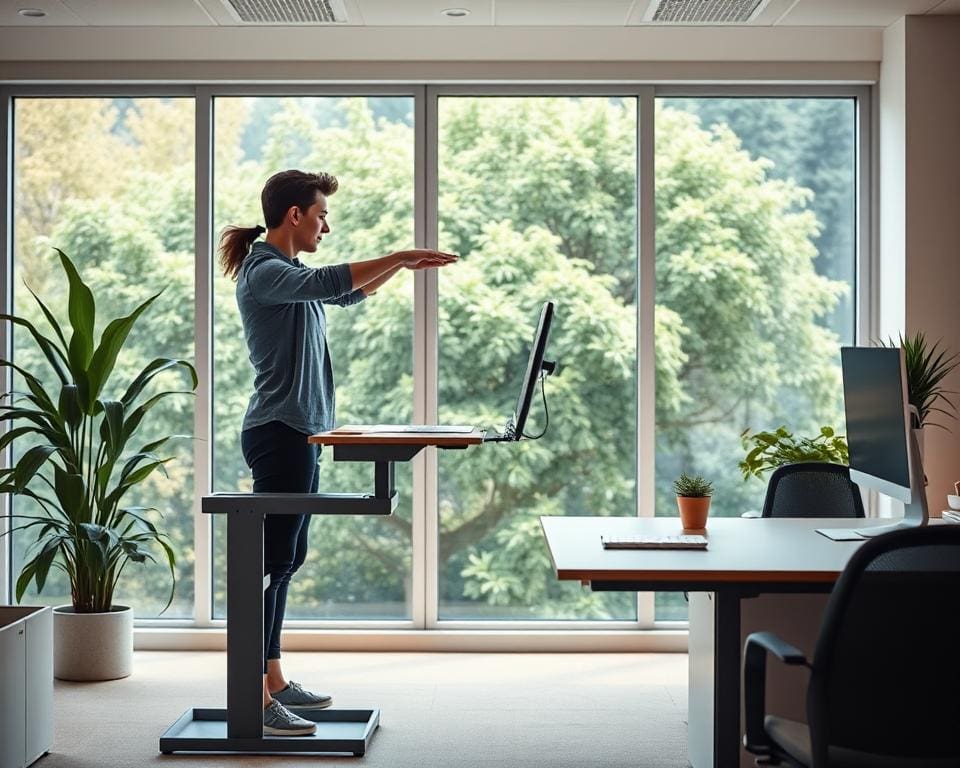In today’s fast-paced work environment, marked by an increasing dependency on technology, many individuals find themselves leading a sedentary lifestyle. Understanding how to avoid a sedentary lifestyle at work is essential for maintaining both physical and mental well-being. Prolonged periods of sitting can lead to serious health issues such as obesity, cardiovascular disease, and musculoskeletal pain. As we navigate through this article, we will provide active working tips and strategies for sedentary lifestyle prevention that can easily be integrated into your daily routine. By embracing movement and activity during your working hours, you can cultivate healthier habits that elevate your overall quality of life.
The Importance of Staying Active at Work
The significance of staying active at work cannot be overstated. Engaging in regular physical movement is essential for maintaining both mental and physical health. Prolonged periods of sitting can lead to a variety of health issues, including increased stress, lowered mood, and decreased concentration. These factors can negatively impact overall productivity and workplace satisfaction.
Incorporating activity into your daily routine fosters Healthy Work Habits. Research indicates that employees who prioritise movement experience enhanced job satisfaction and reduced absenteeism. A dynamic work environment, where team members are encouraged to move, not only combats fatigue but also nurtures better communication and collaboration.

Understanding how to prevent a sedentary lifestyle is a pivotal step towards creating a healthier work atmosphere. Simple initiatives, such as taking short breaks to stretch or walk, contribute significantly to an active work culture. By acknowledging the importance of staying active, employees can transform their daily work routines, leading to improved health outcomes and a more vibrant office environment.
How To Avoid Sedentary Lifestyle At Work
Understanding the concept of sedentary behaviour is essential for fostering a healthier workplace. Sedentary behaviour refers to any waking activity characterised by low energy expenditure, primarily involving sitting or lying down. This includes desk work, screen time, and meetings that keep individuals stationary for long periods. By recognising common triggers and types of sedentary behaviour at work, employees can cultivate a mindset geared towards movement and productivity.
Understanding Sedentary Behaviour
Identifying sedentary behaviours prevalent in the workplace serves as a starting point. Many workers spend the majority of their days seated, with minimal physical activity incorporated into their routines. Awareness of how often one finds themselves in these situations will prove beneficial when finding effective Sedentary Job Health Tips. Measures can include standing during phone calls or having conversations while walking. These simple adjustments can aid in actively combating a sedentary lifestyle.
The Health Risks of a Sedentary Lifestyle
Prolonged sitting poses significant health risks that warrant attention. Research has established connections between sedentary behaviour and various medical issues, including obesity, diabetes, cardiovascular diseases, and potentially certain cancers. Mental health may also be adversely affected, with increased rates of anxiety and depression noted in sedentary individuals. Recognising these health risks of a sedentary lifestyle can inspire workers to adopt strategies on How to Avoid a Sedentary Lifestyle at Work, integrating more activity into their daily routine.
Incorporating Desk Exercises into Your Day
Incorporating Desk Exercises into your daily routine enhances productivity while combating a sedentary lifestyle. Engaging in these activities can easily become part of your workday without causing disruption. Implementing simple Desk Exercises provides a framework for employees to Stay Active at Work, fostering an environment of movement and wellness.
Simple Desk Exercises You Can Do
There are numerous Desk Exercises that can easily fit into your work schedule. Below are some effective movements you can perform right at your desk:
- Seated leg raises: Lift one leg at a time, holding for a few seconds to engage your core.
- Shoulder stretches: Reach one arm across your body, using the opposite hand to gently push for added stretch.
- Wrist exercises: Rotate your wrists in circles, flexing and extending to alleviate tension.
The Benefits of Stretching at Your Desk
Regularly incorporating stretches into your workday unlocks significant benefits. The Benefits of Stretching include enhanced flexibility, improved circulation, and a reduction in muscle tension. These elements can significantly decrease discomfort associated with long hours of sitting. Encouraging employees to adopt stretching as part of their routine contributes to a healthier workplace, fostering overall well-being.
Creating a Movement-Friendly Workspace
Designing a workspace that promotes movement is essential for fostering healthy work habits among employees. Selecting the right furniture plays a vital role in encouraging mobility throughout the day. Ergonomic options such as sit-stand desks and adjustable chairs can significantly improve comfort and productivity. By thoughtfully arranging the workspace, companies can cultivate an environment that empowers their team to embrace a more active lifestyle.
Choosing the Right Furniture for Active Work
Investing in ergonomic furniture is a fundamental step in creating a movement-friendly workspace. When choosing equipment, consider options that facilitate both sitting and standing positions. Sit-stand desks allow for effortless transitions, encouraging employees to change their posture throughout the day. Opting for furniture that promotes collaboration, such as communal tables, can lead to increased interactions and a more dynamic working atmosphere.
Utilising Standing Desks Effectively
Standing desks are a popular choice for those aiming to integrate more movement into their work routine. To maximise their benefits, workers should alternate between sitting and standing at regular intervals. Positioning the desk at the correct height is crucial, ensuring that elbows remain at a 90-degree angle while typing. Maintaining proper posture is essential to avoid discomfort and fatigue, allowing for a more enjoyable work experience.
Healthy Work Habits to Cultivate
Incorporating healthy work habits can significantly enhance well-being and productivity. Developing routines that encourage movement and mindfulness is essential. Establishing a consistent Break Routine is one of the most effective strategies to Avoid Sedentary Lifestyle at Work. Regular breaks not only promote physical activity but also clear the mind, allowing for increased focus and creativity.
Establishing a Break Routine
Integrating regular breaks into the workday can transform how individuals approach their tasks. Implementing methods such as the Pomodoro Technique promotes short breaks paired with bursts of activity, fostering a refreshing escape from the screen. Consider the following strategies:
- Schedule breaks every hour to stand, stretch, or walk.
- Use reminders or apps to signal when it’s time to take a break.
- Involve colleagues in short activity bursts to enhance motivation.
Tracking Your Activity Levels
Becoming aware of personal activity levels is vital for cultivating Healthy Work Habits. Various tools and apps can assist employees in Tracking Activity Levels effectively, making it easier to set and achieve movement goals. By monitoring daily habits, individuals gain insights into their behaviour and can make informed choices. Here are a few helpful suggestions:
- Utilise fitness trackers or smartphone apps to monitor steps and activity duration.
- Set daily movement reminders to encourage consistency.
- Review progress weekly to make necessary adjustments and maintain motivation.
Active Working Tips for a Healthier Day
Implementing simple strategies can transform a sedentary workday into a more active one. This section explores two effective Active Working Tips that can integrate seamlessly into your routine, enhancing your well-being and productivity.
Incorporating Walking Meetings
Walking meetings present an excellent opportunity to combine movement with collaboration. These meetings allow teams to brainstorm and discuss ideas while engaging in physical activity. To implement walking meetings successfully, consider the following:
- Plan routes: Choose safe paths within or near your workplace for uninterrupted discussions.
- Set clear agendas: Define objectives to ensure that productivity remains high even while walking.
- Encourage participation: Foster an environment where everyone feels comfortable sharing their thoughts on the go.
Research indicates that walking boosts creativity and engagement, making it a practical choice for enhancing teamwork and innovation during discussions.
Using the Staircase Instead of the Lift
Opting for the stairs rather than the lift offers a straightforward yet effective approach to increase daily activity. This small change has significant health benefits, including:
- Increased calorie burn: Climbing stairs elevates heart rate and can lead to higher energy expenditure.
- Improved cardiovascular health: Regular stair climbing strengthens the heart and promotes better circulation.
- Enhanced endurance: Building a routine of using the stairs encourages overall fitness and stamina.
Promoting a staircase culture in the workplace fosters long-term lifestyle changes, turning physical activity into a natural part of daily routines and helping to combat the sedentary job health tips that plague many environments.
Office Fitness: Group Activities and Challenges
Creating a vibrant, engaging atmosphere at work can significantly improve employees’ well-being and productivity. Office Fitness Challenges provide an exciting way to motivate staff towards a healthier lifestyle. Implementing various group activities encourages participation and camaraderie among colleagues, fostering a sense of teamwork.
Setting Up Office Fitness Challenges
Establishing Office Fitness Challenges can be an excellent way to inspire friendly competition and reduce sedentary behaviour. Consider organising:
- Step competitions, where participants track their daily steps and compete for the highest count.
- Virtual workout challenges, encouraging remote employees to stay active through shared goals.
- Fitness tracking apps, enabling staff to log their activities and share their progress.
These initiatives not only enhance physical health but also strengthen workplace morale as employees bond over shared achievements.
Engaging in Group Workouts
Group Workouts can transform the way your office approaches fitness. By scheduling regular group activities, businesses can create a stimulating environment. Ideas for integrating group workouts include:
- Hiring a personal trainer to lead sessions tailored to varying fitness levels.
- Hosting yoga or Pilates classes during lunch breaks to relieve stress.
- Organising outdoor activities, such as walking or running clubs, to encourage movement in a fun setting.
These collective efforts not only provide health benefits but also promote Office Fitness as a common goal. The bonds formed during these sessions strengthen team relationships and create a supportive culture.
The Role of Nutrition in Avoiding Sedentary Lifestyle
In the fast-paced environment of a desk-bound job, maintaining proper nutrition is essential for sustaining energy levels and encouraging a more active lifestyle. A well-balanced diet, rich in vitamins, minerals, and complex carbohydrates, can significantly enhance your ability to stay active at work. Foods like whole grains, fruits, and vegetables not only provide lasting energy but also improve cognitive function, aiding in productivity throughout the day.
Healthy snacking plays a pivotal role in combatting the effects of a sedentary lifestyle. Opting for nutritious snacks, such as nuts, Greek yoghurt, or carrot sticks, can curb cravings and help maintain energy without the lethargy that often follows sugary treats. Meal planning is equally crucial; preparing balanced lunches and snacks in advance can ensure that you always have wholesome options available, reducing the temptation to indulge in less healthy options during busy days.
Hydration is another key component in the fight against a sedentary lifestyle. Often overlooked, adequate fluid intake can enhance focus and prevent fatigue. Keeping a water bottle at your desk serves as a reminder to stay hydrated, which is instrumental in maintaining both physical and mental vitality. By integrating these essential nutritional strategies into your workday, you can create a holistic approach to staying active at work, ultimately leading to improved health and well-being.









